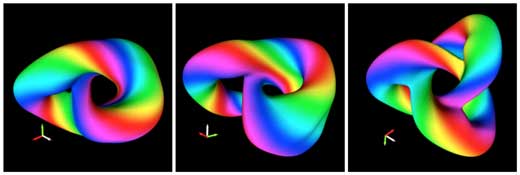| Oct 11, 2019 | |
Funding for research into three-dimensional magnetic nanostructures(Nanowerk News) Professor Mathias Kläui at the Institute of Physics of Johannes Gutenberg-University Mainz (JGU) has been awarded together with cooperation partners at Forschungszentrum Jülich and Radboud University Nijmegen in the Netherlands a prestigious ERC Synergy Grant. |
|
| In the "3D MAGiC" project, the partners will explore still largely unknown nanoscale 3D magnetic structures, which show particle-like properties and whose existence has so far only been predicted theoretically. Synergy grants are awarded for groundbreaking projects which, due to their complexity, cannot be carried out alone but only by a team of two to four investigators. | |
| The group in Mainz will receive more than EUR 3 million over six years with a total funding of just under EUR 12 million for the consortium. | |
| Questions such as how particles emerge into the world, what their properties are, and how they interact in external fields are central topics in physics. They are relevant in subjects that range from astronomical dimensions, where they apply to stars, exoplanets and black holes in gravitational fields, to the subatomic scales of elementary particles. Between these dimensions are atoms, molecules, and other nanoscale particles such as so-called magnetic topological solitons, which are governed by the laws of quantum mechanics and electromagnetism. | |
Still puzzling: Three-dimensional magnetic solitons |
|
| The topological magnetic solitions that will be studied in the ERC Synergy Grant are magnetic whirls only a few nanometers large that can be present in particular solid state systems and about which little is known today. | |
| "The first magnetic vortices that were detected can be regarded as two-dimensional objects. We are now at a threshold where it will be possible to experimentally study three-dimensional vortex-like structures. One of our goals is to extend our methods of electron holography for this purpose," explained Professor Rafal Dunin-Borkowski, principal investigator of the project and Director of the Ernst Ruska-Centre and the Peter Grünberg Institute at Forschungszentrum Jülich. | |
| In "3D MAGiC", the researchers want to investigate particles that may have an even greater potential. Among other things, the focus is on so-called hopfions: "These novel particles can be imagined as twisted or knotted shoelaces. The more loops they contain, the higher the Hopf number," said Stefan Blügel, Head of the Institute for Advanced Simulation und Director of the Peter Grünberg Institut at Forschungszentrum Jülich. | |
 |
|
| Hopfions: The larger the number of loops, the larger the Hopf number. The colours reflect the direction of the spins, which define the magnetization orientation. (Image: Forschungszentrum Jülich) | |
| These objects are interesting for future applications: According to theoretical considerations, the Hopf number can assume many different values, which makes these novel particles highly effective as information carriers. If many such particles are collected in a material, then a large store of information can be created. Their spatial extent makes it possible to cross-link them in a variety of ways via spin waves in all three spatial dimensions – a concept that cannot be realized in two dimensions. | |
| For this reason, hopfions may be suitable candidates for innovative approaches in the field of neuromorphic computing, taking inspiration from the human brain, which is very highly connected. Such topics are also currently investigated in the Research Center for Emergent Algorithmic Intelligence at JGU, which was recently founded with funding from the Carl Zeiss Foundation. | |
ERC project complements the top-level research area TopDyn – Topology and Dynamics |
|
| Magnetic heterostructures to host such magnetic solitons will be fabricated in the group of Professor Mathias Kläui at Mainz University. These quasi-particles will then be characterized by highly time-resolved microscopy based on electrons and x-rays. | |
| "I am extremely pleased about the possibility to develop this exciting area of research with these excellent colleagues. The major scientific potential of these often topologically non-trivial solitons complements perfectly our research in TopDyn – Topology and Dynamics, which is funded by the state of Rhineland-Palatinate." | |
| The fourth partner, Professor Theo Rasing of Radboud University in Nijmegen, is a specialist in the ultrafast manipulation and characterization of magnetic nanostructures using laser pulses and will, among other things, investigate how lasers can be used for unconventional computing using 3D nanoscale particles such as hopfions. As an additional partner from outside Europe, Professor Xiaoyan Zhong from Tsinghua University in Beijing, China, is involved in the further development of the characterization methods. |
| Source: Johannes Gutenberg-University Mainz | |
|
Subscribe to a free copy of one of our daily Nanowerk Newsletter Email Digests with a compilation of all of the day's news. |
